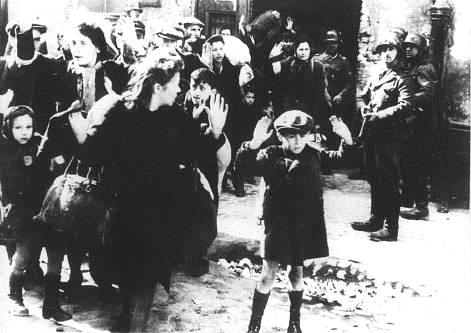Anne Frank
 Opposite:
Opposite:Anne Frank, age 13, at the Jewish Lyceum in Amsterdam
"It's really a wonder that I haven't dropped all my ideals, because they seem so absurd and impossible to carry out. Yet I keep them, because in spite of everything I still believe that people are really good at heart."--Anne Frank
I have recently seen the film version of Anne Frank, Diary of a Young Girl starring Ben Kingsley and Hannah Taylor-Gordon, and have found it to be one of the most profoundly moving, and saddening films I have ever seen.
The film, which is in color, begins in a very amiable way, presenting Anne Frank as any other young girl, enjoying life and being young. She is also very talented, and full of a richness of character that is at once endearing and sympathetic.
That this film is well-done goes without saying, but the final forty-five minutes of the movie are so intensely difficult to watch that I would not relish seeing the movie twice.
 Otto Frank's office at 263 Prinsengracht, where the Frank family went into hiding in the beggining of July 1942. Of the eightpeople who were in hiding here for two years, only Otto Frank survived after discovery and arrest by the Gestapo.
Otto Frank's office at 263 Prinsengracht, where the Frank family went into hiding in the beggining of July 1942. Of the eightpeople who were in hiding here for two years, only Otto Frank survived after discovery and arrest by the Gestapo.We are witness to the final disintegration of a broken child, as she is starved, beaten, treated with a coldness and hateful contempt she could scarcely have ever been use to, and dehumanized in a way that is pitiful and shocking in the same measure. One by one, the niceities that were presented in the first part of the film are stripped away until, finally, we are left with a starving, filthy little girl dying of typhus amid the hell-on-earth that had been set up to annihilate a population of humanity that had been deemed "inferior" by the Third Reich of Adolph Hitler; who despite being in the final throes of losing the war, proceeded with a hellish fury in their plan to exterminate the remaining Jews in occupied Europe.
The actress who portrayed Anne Frank, Hannah Taylor-Gordon, was the very picture of the authoress, and her haggard, terminal visage in the last part of the film is nearly reminiscent of Falconetti in Karl Theodor Drayer's silent classic The Passion of Joan of Arc.
 Anne Frank with her childhood friends, 1937. Anne is second from left.
Anne Frank with her childhood friends, 1937. Anne is second from left.Although it seems unlikely that any person alive could not be, dimly, aware of the story of Anne Frank, it essentially involves the two-years spent in hiding of the Frank family in occupied Amsterdam, Holland, as well as some of their close associates. The family was kept in an unoccupied building in the back of Mr. Otto Frank's manufacturing business, and Anne chronicled those years in a now-famous diary that was discovered and published after the war.

The Frank family, as well as the Van Pels family, and another man, were betrayed to the Gestapo by an unknown informant, and sent to Thierisenstadt Transit Camp. From their, they are sent by cattle cart to Auschwitz. The girls, Margot and Anne Frank, were later sent to the typhus-infested camp at Bergen-Belsen, where living conditions were deplorable and inhumane. Their final months are recorded in heartbreaking testimony by friends and witnesses that knew them during those final days, and preserved in the book The Last Seven Months of Anne Frank by documentary filmaker Willy Linder. Anne Frank died sometime in March of 1945, presumably of starvation and typhus, within a day or so of her sister Margot.
She was just fifteen years old.
Of the original occupants of the attic hiding place, only Otto Frank survived, having lost his entire family to the atrocity of the Nazi program. Miep Gies, a Dutch friend of the family, had carefully preserved Anne's diary, a record of the family's two years in hiding, and Mr. Frank worked to have it published.
To this date,it has been translated into sixty-seven languages, and is the most widely-read nonfiction book of all time, after The Holy Bible. The attic hiding-place, behind Otto Frank's business, has been transformed into the Anne Frank House, and has attracted tourists from around the world.
The most moving scene of this new film of Anne Frank is after the death of her sister, when Anne while holding the body of her beloved sister, seemingly looks to the sky, perhaps looking for a sign of God in the middle of this unrelenting torment. We see the sky move past her face.
The viewer is spared the death of Anne, and the film ends. I was left only with the thought that, after this point in the story, she belonged to history, having impacted it in a way few other young women her age had ever managed to do.
And, also, that no one could hurt her now, anymore...
"...But because we know that Anne did not survive, that this life of enormous potential was snuffed out in the Holocaust, the Diary has a poignancy that is at once unbearable and transfiguring. Through this attractive young woman, the Holocaust is made real: Anne Frank has become for our time the emblem of lost possibility."--From The World Must Know by Michael Berenbaum, Ph.D.
Note: We have had some computer difficulties this evening, and some of the images and material for this particular post are not yet here. We will add this in the immediate future.



































 Jewish victims at Babi Yar pass corpse in the street.
Jewish victims at Babi Yar pass corpse in the street.



